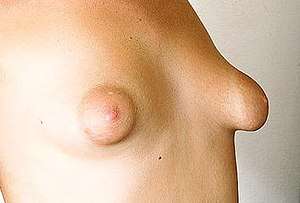Tuberous breasts
Tuberous breasts (or tubular breasts) are a result of a congenital abnormality[2] of the breasts which can occur in both men and women (also see Hypoplasia), one breast or both. During puberty breast development is stymied and the breasts fail to develop normally and fully. The exact cause of this is as yet unclear; however, a study in 2011 of the cells in the breasts of both males and females with tubular breasts suggested a genetic link in a disorder of collagen deposition.[3] The condition is thought to affect one to five per cent of breast augmentation patients;[4] however, the proportion of the general population affected is unknown as surgery is not always sought.
| Tuberous breasts | |
|---|---|
 | |
| A pair of tuberous breasts displaying typical characteristics such as minimal breast tissue and enlarged, puffy areola. | |
| Complications | low milk production[1] |
| Usual onset | puberty |
| Duration | life |
| Treatment | breast augmentation |
| Prognosis | benign |
| Frequency | unknown |
Background
The tuberous breast deformity was first described by Rees and Aston in 1976[5] following which a method of classifying the severity was developed. The surgical classifications refer to which areas of the breast are affected and is divided into three grades; mainly in the inferomedial quadrant (Grade I); in the two inferior quadrants (Grade II); or affecting the whole breast (Grade III).[6]
Synonyms
This condition is also known as constricted breasts, tubular breasts, herniated areolar complexes,[3] conical breast, domen nipple, lower pole hypoplasia and hypoplastic breasts.
Physical effects
Tuberous breasts are not simply small or underdeveloped breasts. The effect of the condition on the appearance of the breast can range from mild to severe, and typical characteristics include: enlarged, puffy areola, unusually wide spacing between the breasts, minimal breast tissue, sagging, higher than normal breast fold,[7] and narrow base at the chest wall. The condition can cause low milk supply in breastfeeding women.[8] However, other physical aspects of fertility and pregnancy are not affected by the condition.
Psychological effects
Any deformity of the breasts is only apparent during puberty and this may lead to psychosexual problems with girls in very early puberty being affected psychologically due to the unusual shape of the breast.[6] Surgical papers about the techniques useful in correcting tubular breasts note that even when results are not perfect, the psychological impact of treatment is immense, with notable improvements in self-esteem to the level where the person engages in normal social activities.
Treatment
The appearance of tuberous breasts can potentially be changed through surgical procedures, including the tissue expansion method and breast implants.[9]
The procedure to change the appearance of tuberous breasts can be more complicated than a regular breast augmentation, and some plastic surgeons have specialist training in tuberous breast correction. A less complicated single-stage approach using saline implants can also provide a satisfactory aesthetic result. [10] As tuberous breasts are a congenital deformity, referral for treatment under the National Health Service may be possible in the United Kingdom.[11] A starting point for those seeking such a referral may be a visit to their local General Practitioner. For those seeking non-surgical solutions, counseling may be recommended as a way of coming to terms with body image.
References
- Panchapakesan V, Brown MH (January 2009). "Management of tuberous breast "deformity" with anatomic cohesive silicone gel breast implants". Aesthetic Plast Surg. 33 (1): 49–53. doi:10.1007/s00266-008-9234-7. PMID 18752021.
- Klinger, Marco; Caviggioli, Fabio; Klinger, Francesco; Villani, Federico; Arra, Erseida; Di Tommaso, Luca (2011). "Tuberous breast: Morphological study and overview of a borderline entity". Canadian Journal of Plastic Surgery (in English and French). 19 (2): 42–44. doi:10.1177/229255031101900210. PMC 3328117. PMID 22654530.
- "Breast Augmentation...on Tubular Breasts". Retrieved 2010-03-14.
- Rees, S; Aston, S (1976). "The tuberous breast". Clin Plast Surg. 3 (2): 339–46. PMID 1261187.
- Gabka, Christian J; Heinz Bohmert (2008). Plastic and Reconstructive Surgery of the Breast. p. 72. ISBN 9783131035721. Retrieved 7 December 2013.
- Tubular Breast Correction
- Amir, LH (2006). "Breastfeeding--managing 'supply' difficulties". Australian Family Physician. 35 (9): 686–9. ISSN 0300-8495. PMID 16969436.
- Dennis C. Hammond (3 December 2008). Atlas of Aesthetic Breast Surgery. Elsevier Health Sciences. pp. 187–. ISBN 978-1-4160-3184-0. Retrieved 2 May 2010.
- Eisenberg, Ted (April 13, 2009). "One-Stage Correction of Tuberous Breast Deformity Using Saline Implants: Without the Need for Radial Scoring or Lowering the Inframammary Fold". American Journal of Cosmetic Surgery: 074880681984146. doi:10.1177/0748806819841466.
- Policy for Cosmetic Surgery Referrals